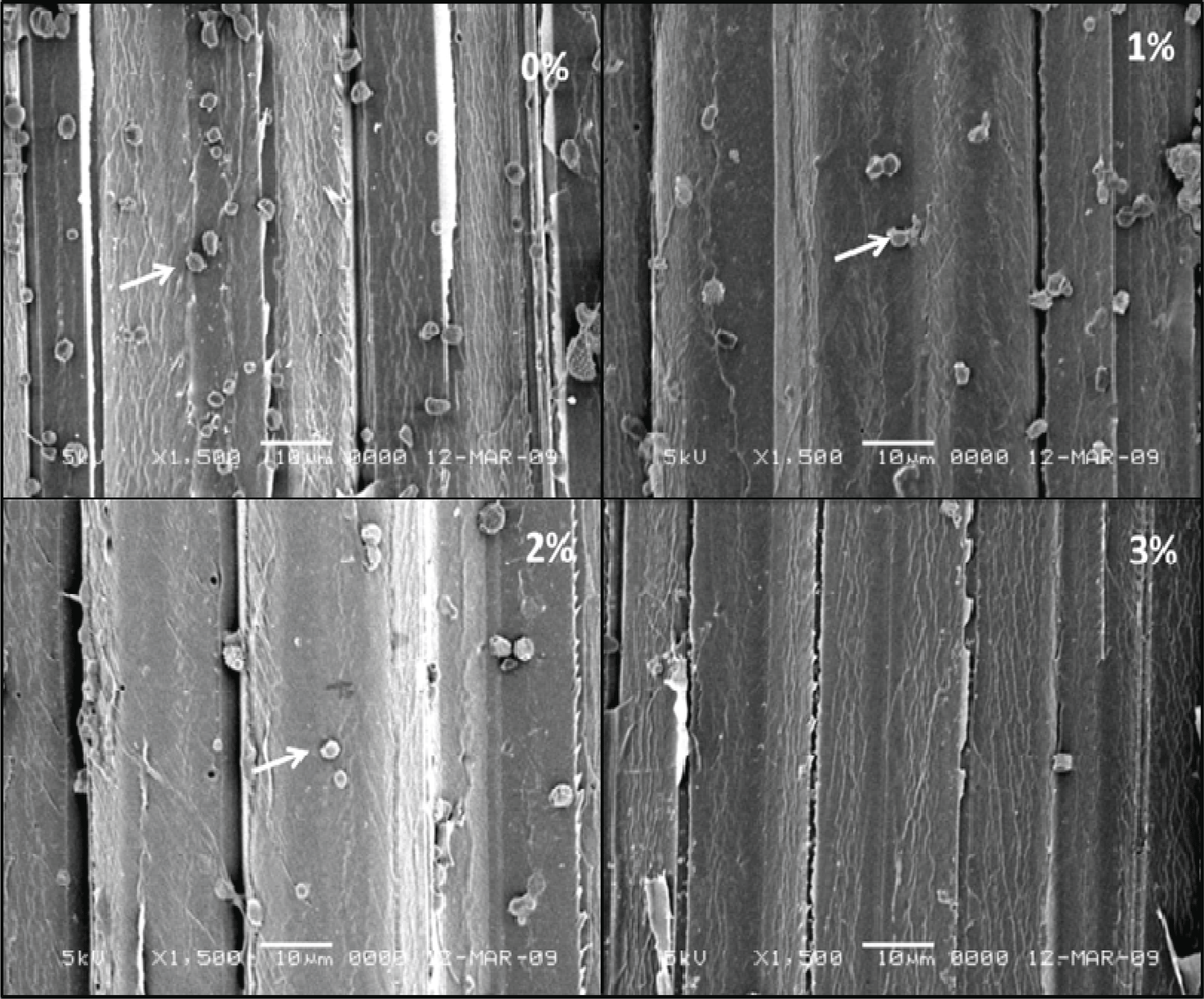1. INTRODUCTION
Bamboo is a potential alternative raw material for wood resources due to its rapid growth, abundant amount, growing widespread, and high tensile strength (Liese, 1987). Generally, bamboo has a small diameter with tubular shape and thin culm, thus the utilizations of solid bamboo are inflexible and more appropriate to be raw material for composites. However, bamboo has a high content of starch and others extractives which may responsible for low dimensional stability and bonding property of the bamboo composite (Febrianto et al., 2015).
Among the bamboo species, Betung bamboo has a high potential to be used for board manufacturing and light-construction due to its big culm size. It can grow as high as 30 m with diameters of about 14 cm at the bottom part (Park et al., 2018) and is distributed in tropical regions such as Indonesia, Malaysia, Thailand, Vietnam, and so forth (Dransfield and Widjaya, 1995). Up to date, there are many our studies on the composite properties using the bamboo materials (Febrianto et al., 2015; Maulana et al., 2017; Fatrawana et al., 2019).
In order to improve the properties of bamboo composite, pre-treatment of bamboo strands can be applied to reduce the undesirable chemical component in the bamboo strands. Steam treatment at high temperatures can degrade low molecular weight substances and convert the free sugar groups into furan resins (Rowell, 2004). In the relatively low temperature at around 120 °C, steam treatment is known to reduce the extractive content of bamboo up to 3% and significantly increase the physical and mechanical properties of OSB (Maulana et al., 2017). However, during steam treatment, the extractive substances can be deposited and accumulated on the surface of strands. This circumstance can affect the bonding process by inhibiting the penetration of adhesive into the cell wall (Pizzi, 1983).
Sodium hydroxide solution may washing the chemical components on the surface of bamboo strands, which expects the enhacement of the adhesion properties of bamboo composites. Therefore, this study tried to investigate the effect of washing treatment using sodium hydroxide solution after stream treatment on the chemical compositions of bamboo strands.
2. MATERIALS and METHODS
The Betung bamboo culms were harvested from Sukabumi District, West Java, Indonesia. Bamboo strands were prepared from the internode of bamboo culm without the outer layer part and node using a sharp knife and scissor with target size (70 × 25 × 0.7) mm3. All chemicals used in this experiment were analytical grade.
Steam and washing treatment were carried out according to Maulana (2019). Steam treatment was conducted in an autoclave at 126 °C for 1 hour under 0.14 MPa pressure. Washing treatment after steam treatment was carried out with sodium hydroxide solution at the concentrations of 1%, 2%, 3%, 4%, and 5% for 30 sec. Steam-treated sample without washing (0%) was also prepared as a comparison. The treated strands were air-dried and then oven-dried for 36 hours to get moisture content below 5%.
Holocellulose and α-cellulose content were determined by the Browning methods (Browning, 1967) and lignin was by the method of Dence (1992). Extractives soluble in cold and hot water were determined according to TAPPI T-207 cm-99 (TAPPI, 1999). Extractives soluble in Ethanol-benzene determination method referred to ASTM D-1107-96 (ASTM, 2013). Solubility in 1% NaOH solution was determined according to TAPPI T-212 om-02 (TAPPI, 2002). The pH value was determined according to SNI 06-6989.11-2004 (BSN, 2004).
The bamboo powder was used for chemical composition analyses using the ATR method in the range of 400-4000 cm-1 with an FT-IR spectrometer (Perkin Elmer Inc., USA) installed in the central laboratory of Kangwon National University, Korea.
An X-ray diffractometer (DMAX 2100V, Rigaku, Japan, 40 kV, 40 mA) equipped with a Cu target (λ=0.1542 nm) was used for measuring crystalline properties. The relative crystallinity and crystal width of betung bamboo strands were analyzed using Seagal’s method (Seagal et al., 1959) and Scherrer’s equation (Burton et al., 2009). To investigate the surface morphology of the Betung bamboo strands, the strands surface was goldcoated with a Gressington sputter coater (ULVAC G-50DA) and observed with a scanning electron microscope (JSM- 5510, JEOL, Japan, 15 kV).
The experiment was a completely randomized design with one factor: sodium hydroxide concentration of six levels. Each treatment was carried out in four replications. The data obtained were statistically analyzed using analysis of variance (ANOVA). Furthermore, Duncan's multiple range test was carried out if there was a significant influence.
3. RESULTS and DISCUSSION
Holocellulose contents of the steam-treated bamboo strands decreased with increasing alkali concentration in washing treatments as shown in Fig. 1. The significant decrease of holocellulose mainly occurred in the samples washed with 4% NaOH solution. The statistical analyses showed that the washing treatment had a significant effects (P <0.01) to the contents of holocellulose, α-cellulose, and hemicellulose.
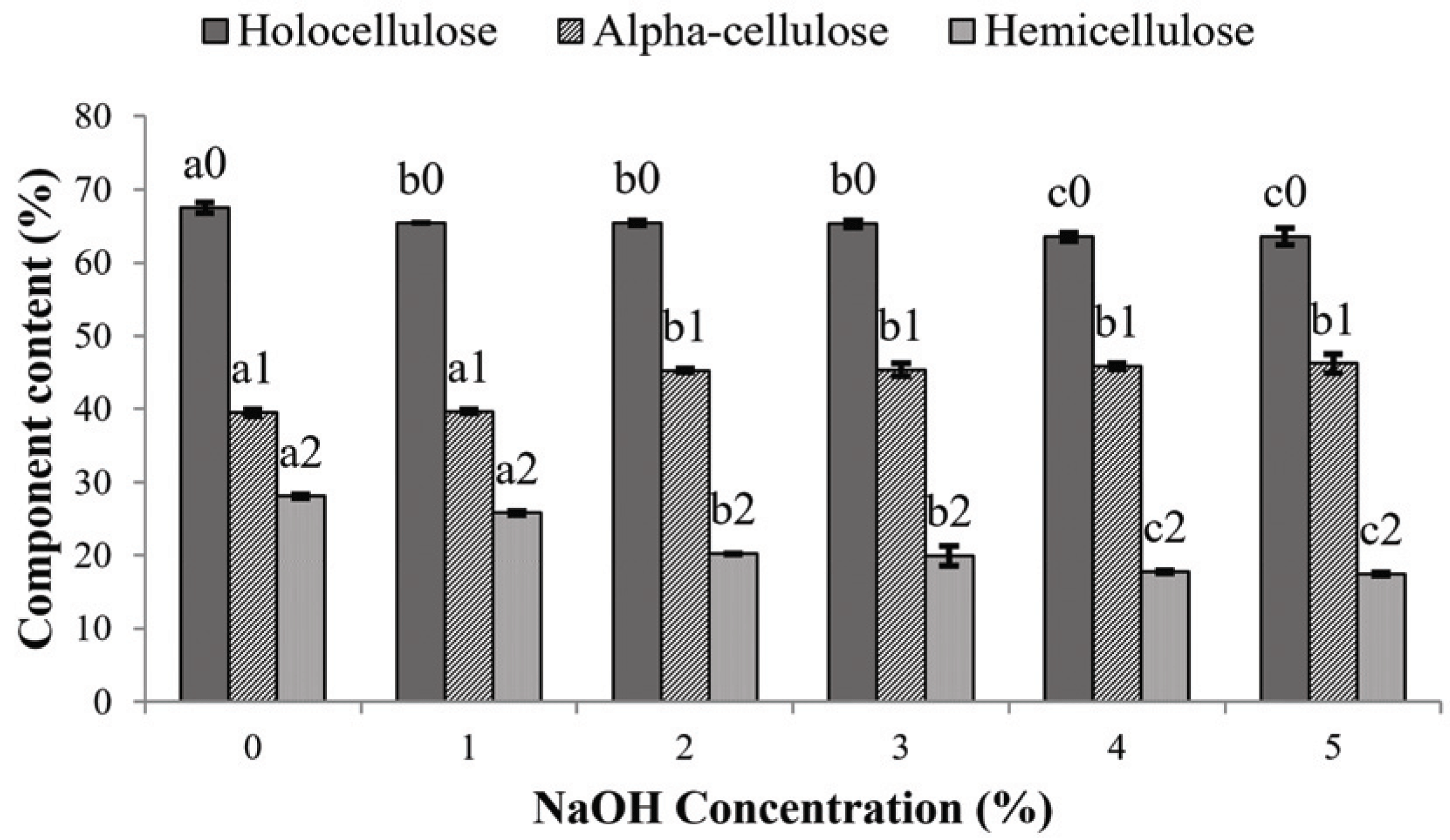
Holocellulose content might be decreased mainly due to the degradation of hemicellulose. Hemicellulose is an amorphous polymer with a low degree of polymerization, and more susceptible to the degradation by alkali (Fengel and Wegener, 1984). Alpha-cellulose was slightly changed in alkaline washing treatments at concentrations of 2%, and remain stable at higher concentrations of up to 5% NaOH. The proportion of α-cellulose in holocellulose increased slightly with decreasing of hemicellulose content. In the previous study, it was reported that hemicellulose content decreased by steam and washing treatment, thus increasing the proportion of alpha-cellulose content (Maulana et al., 2018). The NaOH solution is able to swell the structure of cellulose polymer even at room temperature conditions (Zhang et al., 2013). Changes in the chemical properties of holocellulose may alter the mechanical properties, hygroscopic properties, and the water absorption capacity of the materials.
Lignin content of the bamboo strands decreased by alkali washing treatment as shown in Fig. 2. The results of the analysis of variance (α= 0.05) showed that the alkali treatment had a highly significant effect (P <0.01) on the lignin content of Betung bamboo strand. The higher alkali concentration, the lower lignin content of the strands. Jung et al. (2017) also found that alkali treatment of steamed barley husk reduced lignin content. Alkali treatment at higher concentration produces lower lignin content (Yang et al., 2019).
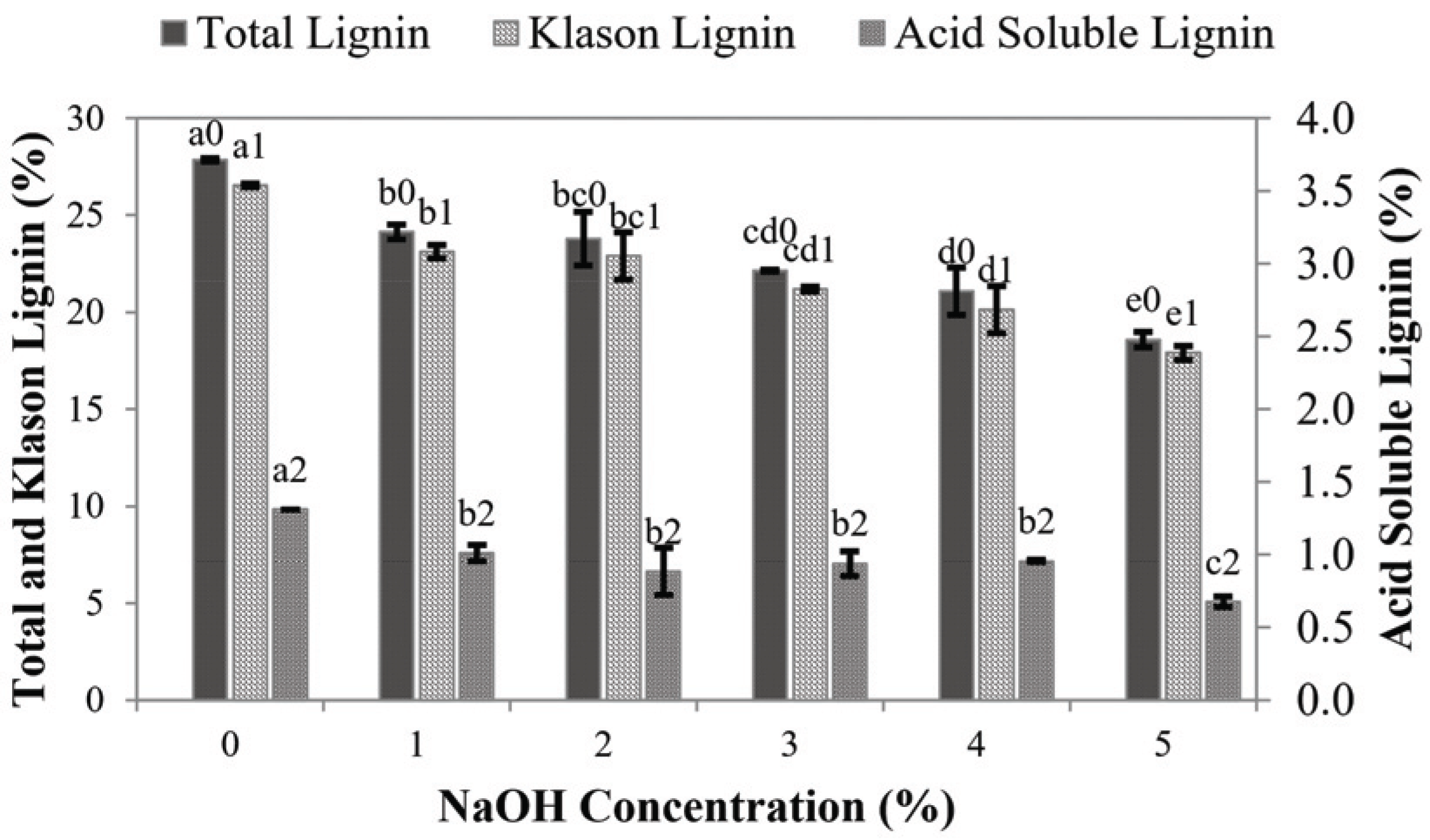
In this research, acid soluble lignin of the bamboo strands also decreased by alkali washing treatment. The changes of acid-soluble lignin content indicated that the composition of lignin was changed to some extent as a result of partial delignification. Acid-soluble lignin produced during Klason lignin procedure was affected by syringyl unit (Matsushita et al., 2004). In alkali condition syringyl unit is more easily degraded than guaiacyl units (Nawawi et al., 2017), which is due to syringyl is more reactive than guaiacyl (Tsutsumi et al., 1995). Thus the decrease of acid soluble lignin could be caused by syringyl unit degradation. Lignin plays a role as a supporting component for mechanical properties of plant cells. The changes in lignin content and its chemical properties will affect the mechanical properties of the lignocellulose material.
Table 1 shows the soluble contents in the bamboo strands in cold and hot water, 1% alkali and ethanol- benzene solutions. The highest content of extractives of bamboo strand was shown in 1% NaOH solution. It might be due to high starch content in bamboo (Fatrawana et al., 2019). On the solubility in 1% NaOH, the extractives in the alkali-washed bamboo strands was lower than the unwashed strands except washing at 5% NaOH solution, suggesting that the degradation of chemical components on the surfaces of the bamboo strands occurred even during short alkali-washing treatment. The bonding quality of bamboo composites can be improved owing to the decrease of extractive substances of alkali-washed bamboo strand. Pizzi (1983) explained that the extractive substances may inhibit adhesive penetration into the wood substrates during bonding process.
The pH value of unwashed Betung bamboo strands was 5.79 and then increased by alkali-washing treatment as shown in Fig. 3. Acidity could be influenced by polyphenols and organic acids present in woody materials (Krilov and Lasander, 1988). Organic acids in wood were found as acetic acid, formic acid, polyphenols and as acetyl groups in hemicellulose, which are easily hydrolyzed into free acids (Nawawi et al., 2012). Since alkali washing treatment decrease extractives content and degrade hemicellulose, it is expected that organic acids were reduced and followed by increasing the pH value. In addition, the pH values that tend to be alkaline might be caused by the residual of NaOH after washing treatment. The higher concentration of NaOH residues on the strand surface could result in higher pH value. The results of the analysis of variance (α= 0.05) showed that the treatment had a very significant effect (P <0.01) on the pH value. In the bonding process, the higher pH value is an appropriate condition for the curing process using phenol formaldehyde (PF), which is categorized as an alkaline-curing resin. It is known that the curing process of PF resin is effective in the pH value above 9 (Pizzi and Stephanou, 1993).
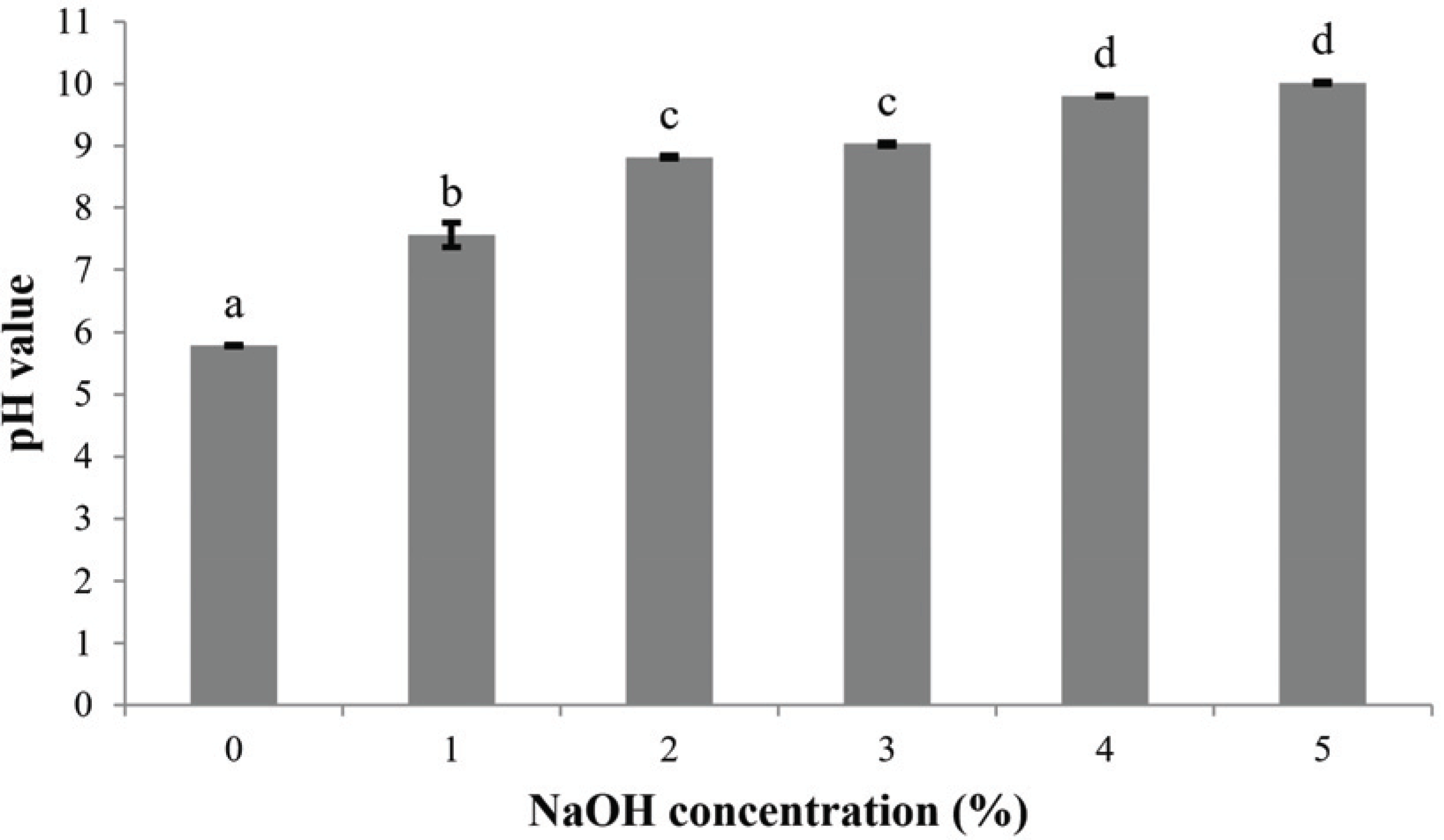
Different letters show significant differences between treatments according to Duncan multiple range test at 5% confidence interval. Error bars show standard deviation.
Fig. 4 shows the FTIR spectra of the alkali-washed bamboo strands after steam treatment. The corresponding peak assignments are summarized in Table 2. The changes in the spectra after alkali washing at different concentrations were found at the peak at 1728 cm-1. The absorbance at 1728 cm-1 attributed to C=O stretching vibration from hemicellulose (xylan) disappeared by alkali washing. The peaks at 1595 cm-1 related to aromatic skeletal vibration in lignin also decreased. The peak at 1240 cm-1 in unwashed bamboo strand may be the result of approximately equal intensities overlapping at 1270 cm-1 (related to G ring lignin) and 1230 cm-1 (C-C, C-O, C=O stretch), which is (Faix 1991; Cheng et al., 2013). The peak at 1249 is the characteristics of Graminae lignin, which consist of p-hydroxyphenyl, guayacyl, and syringyl unit, presence in the bamboo. However, the peak intensity at 1240 cm-1 has decreased after washing treatment and followed by appearance peak at 1262 cm-1 corresponding to guaiacyl lignin in the alkali washed samples. These changes may be related to the decrease of acid soluble lignin value due to syringyl unit in the alkali treated samples. As mentioned above, syringyl unit is more reactive and easily degraded by alkali, compared to guaiacyl unit. Another change is showed by a decrease of peak intensity at 833 cm-1 after washing with 5% NaOH. This peak is indicative for p-hydroxyphenyl lignin unit (Faix 1991).
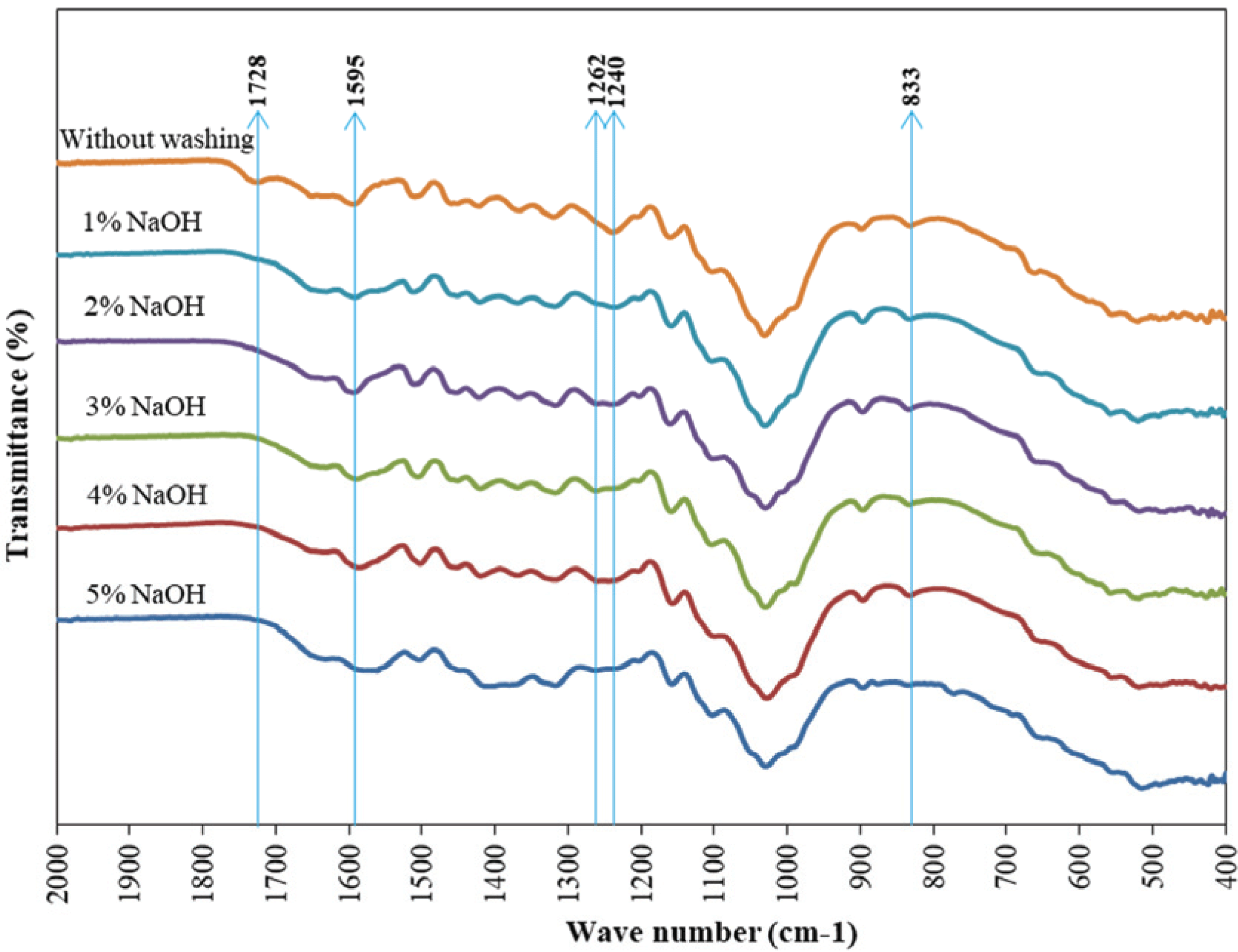
| Component | Wavenumber (cm-1) | Peak Assignment |
|---|---|---|
| Carbohydrate | 1728 | Unconjugated C=O in hemicellulose (xylans) (Cheng et al., 2013; Tomak et al., 2013; Lee et al., 2019) |
| Lignin | 1595 | Aromatic ring and C-H bond (Cheng et al., 2013) |
| 1262 | Guaiacyl ring breathing with C-O stretching (Cheng et al., 2013) | |
| 1240 | C-OH aromatic phenyl (Cheng et al., 2013) | |
| 833 | Lignin C-H (Cheng et al., 2013; Tomak et al., 2013) |
The relative crystallinity and crystallite width of the Betung bamboo strands slightly increased by alkali- washing as shown in Table 3. The increase in crystallinity can probably be attributed to the degradation of hemicelluloses (Tang et al., 2019). Andersson et al. (2005) reported that the increase in the size of cellulose crystallites was due to the changes in porosity of the cell wall by the degradation of the amorphous part of wood during heat treatment. Kim et al. (2018) and Kim and Kim (2019) also reported that heat treatment increased the relative crystallinity of Paulownia wood. Higher crystallinity could increase the mechanical properties such as stiffness, MOE and MOR of the OSB with the bamboo strands.
Fig. 5 shows the SEM images of the bamboo strands at various treatments. In unwashed bamboo strands, the degraded products after stream treatment, such as starch granules were scattered throughout the strand surface. Starch granules can usually be found in the bamboo culm, mostly in parenchyma cells (Ito et al., 2015). These products on the strand surface were reduced after alkali-washing treatment, showing clean and smooth surface. The surface morphology of the bamboo strands might be caused by the degradation of lignin and hemicellulose and could affect the bonding property for the composite material.
4. CONCLUSION
Steam followed by washing with NaOH solution affected the change of chemical components of Betung bamboo strand. Washing with higher NaOH concentration affected more severely to the hemicellulose and lignin reduction. The acid soluble lignin content was decreased and syringyl unit degradation was found in FTIR spectra. The extractive content of strand decreased by and the pH value increased by alkali washing treatment. Alkali-washing treatment increased the relative crystallinity and crystalline width of the bamboo strands. The degraded products after stream treatment on the strand surface were reduced by alkali washing treatment, resulting in the smooth and clean surface.

